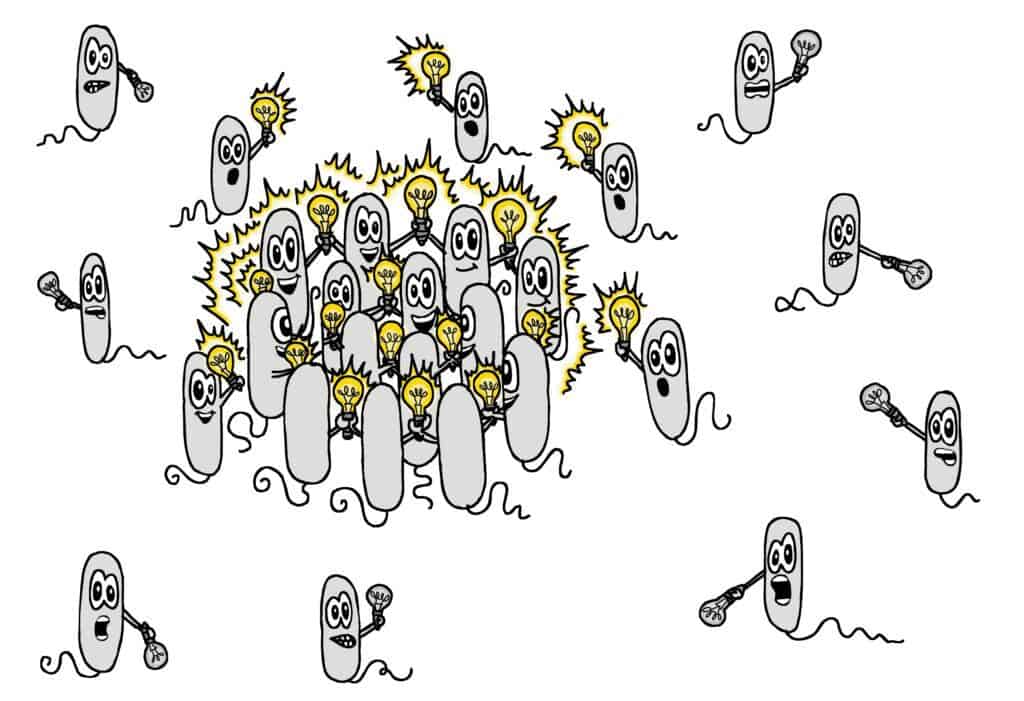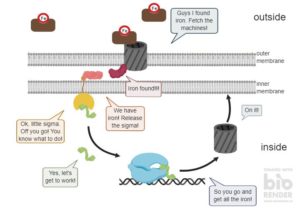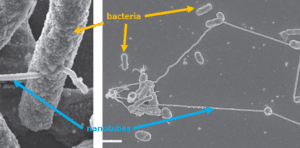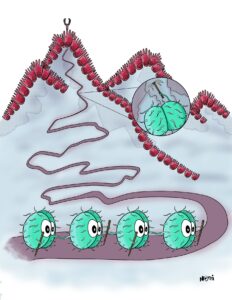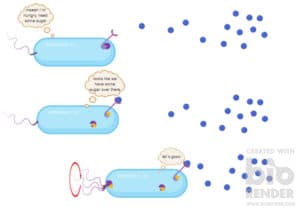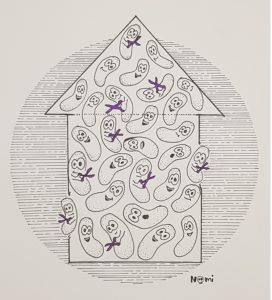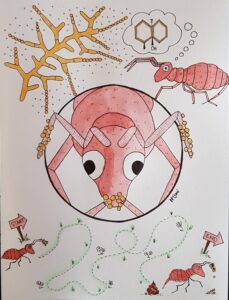Have you ever asked yourself how bacteria know they are not alone?
How are they aware of their bacterial neighbours?
They cannot see them or hear them.
But do bacteria talk to other bacteria?
Yes, they do!
Like humans, bacteria talk to each other and socialize. But obviously, they cannot send messages or call each other. They have completely different communication channels that are not based on words.
So how do bacteria speak to other bacteria and even interact with them?
They use special molecules. Researchers call these kinds of molecules extracellular signalling molecules. This means, bacteria produce these molecules and send them outside of the cell (extracellular). There, they can be a signal to other bacteria.
Microbiologists call this phenomenon quorum sensing. This means that a bacterium “senses” its “quorum”. A quorum means the number of other bacteria in the surrounding. Hence, with quorum sensing, a bacterium knows exactly how many other bacteria are nearby.
The next step is then population-density dependent cell-to-cell communication. This fancy term means that only when enough bacteria are together (a high population), do they talk to each other (cell-to-cell communication).
But why is it important to bacteria to have all this bacterial chatting going on? Do they not like being lonely?
Why do bacteria need to talk to each other?
A community is always stronger than an individual. And the same is true for bacteria.
Many bacteria together can face the harshest environmental challenges. We also discuss the power of microbial communities when talking about multicellular organisms.
But by using quorum sensing, bacterial cells are still individual cells. Yet, they act and react as a community; a real microbial community.
Bacteria have been using quorum sensing for millions of years. And it did shape evolution because bacteria learned to include others in their decision making.

When bacteria face harsh conditions, they use quorum sensing to tell other bacteria in the surrounding that they are not alone. And as a community, they coordinate and tackle that challenging condition together. Therefore, bacteria developed mechanisms that respond to quorum sensing.
For example, only when many bacteria live in the human body do they produce toxic virulence factors to make us sick.
The same is true for biofilms. Bacteria only build their biofilm houses when they have other bacterial neighbours.
On the contrary, a bacterium knows it is completely alone because no quorum sensing is happening. And when the bacterium also has no food, it might decide to sporulate. With this, the lonely bacterium assures to survive on its own until better times come.
Yes, quorum sensing controls a lot in the bacterial life, so how does this important mechanism actually work?
How does quorum sensing work?
It all starts with one bacterium.
One bacterium that produces these special quorum-sensing molecules. Researchers call these molecules autoinducers. And the bacterium sends these autoinducers out into the environment. We call this bacterium the sender.
Now, when another bacterium from the same family is nearby, it can recognize the autoinducer. This bacterium is the recipient. Both bacteria have specific receptors on its surface to which the autoinducer binds.
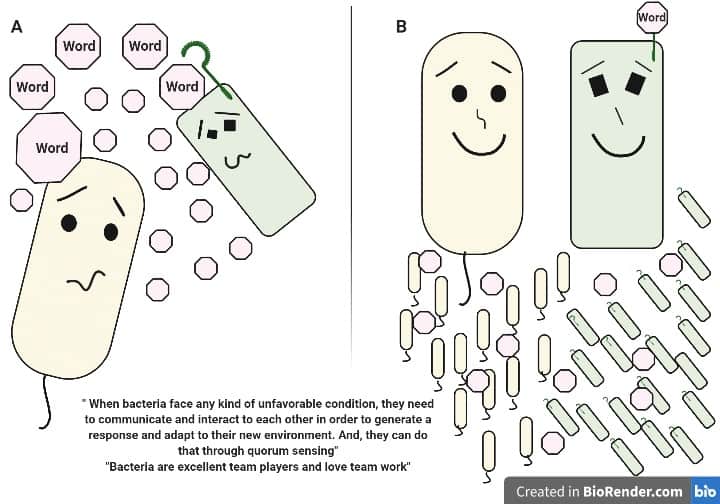
Next, the recipient takes up the autoinducer. Inside the bacterial cell, the autoinducer can regulate genes. But only, when the amount of autoinducer inside the bacterium is high.
Hence, when one bacterium sends out autoinducers, the recipient can only take up a few autoinducers. And these few molecules are not doing much on their own.
But now imagine, there are a hundred bacterial cells around. And each of them produces a few autoinducer molecules. Now, all recipient bacteria take up a lot of autoinducers. And a lot of autoinducers inside a bacterial cell start controlling genes.
All these autoinducers can trigger the bacterium to produce nasty virulence factors or biofilm.
Therefore, with many bacteria around, they produce a lot of autoinducers and more bacteria take them up. Thus, more bacteria listen to each other. And then they produce more autoinducers and send them to the surrounding. Like this, they start chatting and making decisions together.
But what if the chatting bacteria are from different families? Do they still understand each other?
Is quorum sensing a microbial language?
Researchers found that many bacteria use autoinducers to communicate with each other. And they also found that not all bacteria use the same autoinducer to communicate.
It is like speaking different languages.
And interestingly, some bacteria only produce one autoinducer. This is as if they only say one word. All the time.
And other bacteria produce several different autoinducers. So they speak several different words.
Imagine in a mixed microbial community. Different microbes produce hundreds of different autoinducers and send them to the environment. This means hundreds of different words spoken. Therefore, hundreds of different conversations and as such, a lot of chatting going on.
But all these conversations are not always friendly. In some bacteria, quorum sensing also controls killer weapons. As soon as bacteria “hear” via the quorum sensing channel that other bacteria are around, they turn into fighters to kill the neighbour bacteria.
As such, quorum sensing as a microbial language can lead to cooperation or competition between bacteria. And bacteria always try to adapt to new conditions. Therefore, by listening and responding to other bacteria, they developed new mechanisms. This is why quorum sensing played such an important role throughout evolution.
Where can we see bacteria talking in real life?
Scientists can see quorum sensing in the lab all the time. Often they grow bacteria in liquid in a glass flask. At the beginning, the bacteria are not many, so nothing happens.
After a while, bacteria grow in the flask and become a lot more cells and they do quorum sensing. And many bacteria start to produce colourful molecules as a response of quorum sensing.
For example, the bacterium Vibrio fischeri starts producing bioluminescence. Hence, the liquid with the bacteria starts to glow.
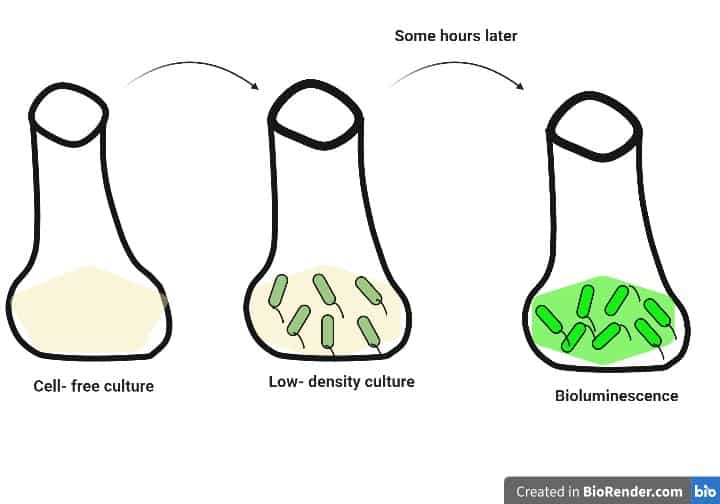
And these bacteria also use bioluminescence in nature. The Vibrio fischeri bacteria usually live inside the so-called light organ of the bobtail squid.
And at night, the bacteria grow and divide and do quorum sensing inside the squid. After a while, the bacteria start producing bioluminescence and the squid shines light towards the seafloor. Like this, it looks as if the squid is not present as it does not throw a shadow anymore.
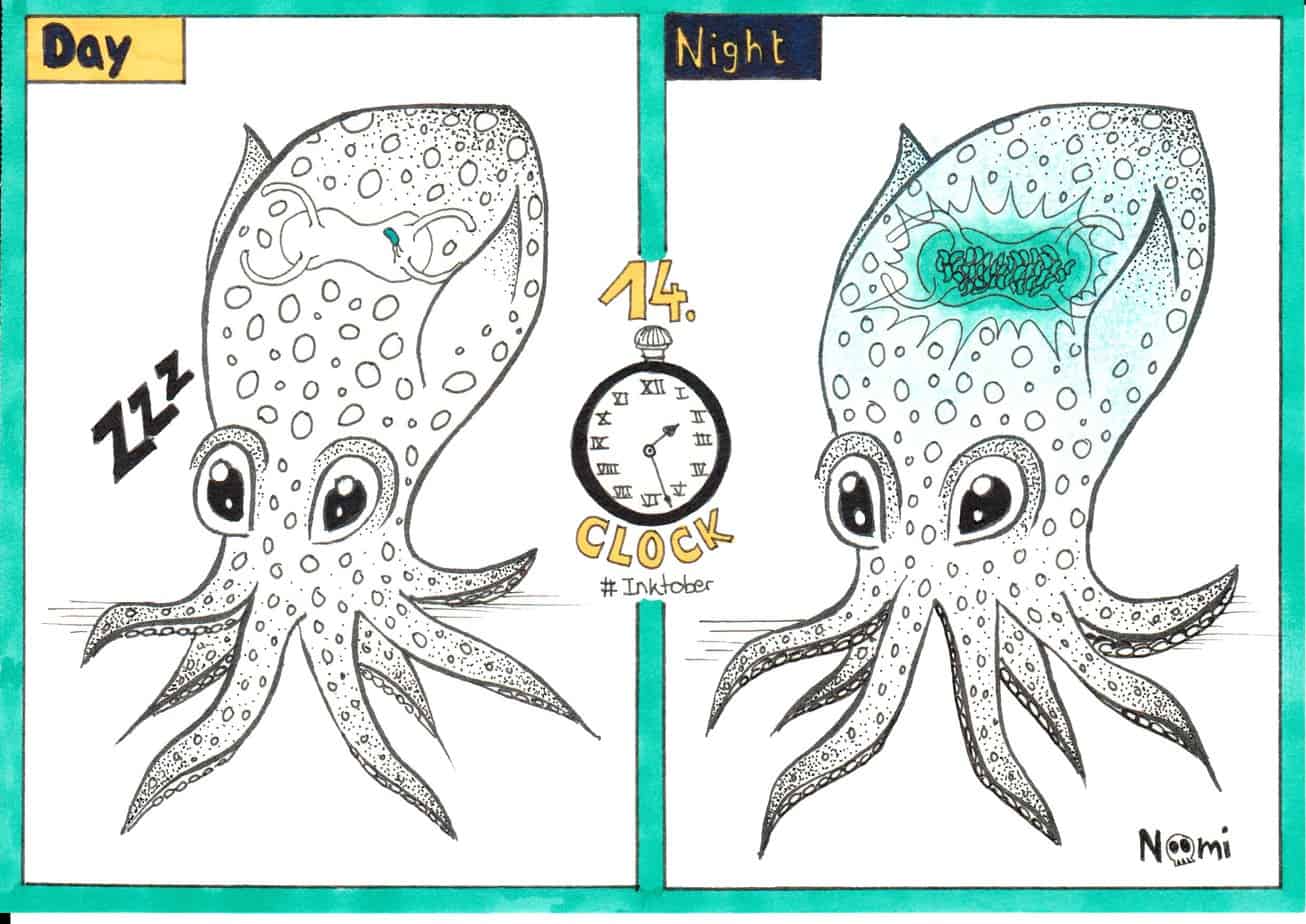
With this mechanism, bacteria help the squid to survive at night. And all this through quorum sensing.
Quorum sensing – a fascinating language
Did we just convince you once again how amazing bacteria are?
Do you also think that quorum sensing is a fascinating language?
And is it not remarkable how bacteria can talk to each other and help each other?
So, yes, we think so. With this amazing mechanism, bacteria know they are not alone. And they can launch an appropriate response to an incoming signal. Just as you say “yes?” when someone calls your name.
However, bacteria have their own language. And we are still learning to understand it.

